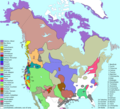File:Langs N.Amer.png

Size of this preview: 661 × 600 pixels. Other resolutions: 265 × 240 pixels | 529 × 480 pixels | 847 × 768 pixels | 1,129 × 1,024 pixels | 1,290 × 1,170 pixels.
Original file (1,290 × 1,170 pixels, file size: 599 KB, MIME type: image/png)
File history
Click on a date/time to view the file as it appeared at that time.
| Date/Time | Thumbnail | Dimensions | User | Comment | |
|---|---|---|---|---|---|
| current | 17:28, 20 July 2019 |  | 1,290 × 1,170 (599 KB) | Denniss | Reverted to version as of 21:52, 1 March 2009 (UTC) |
| 16:54, 13 July 2019 |  | 1,290 × 1,170 (840 KB) | Thylacinus cynocephalus | Having colonial borders on an indigenous language map is offensive | |
| 21:52, 1 March 2009 |  | 1,290 × 1,170 (599 KB) | Malus Catulus | optipng, pngout | |
| 14:31, 22 December 2006 |  | 1,290 × 1,170 (668 KB) | Mahahahaneapneap | pngcrushed | |
| 00:43, 11 November 2006 |  | 1,290 × 1,170 (916 KB) | Ish ishwar | update | |
| 04:55, 1 April 2006 |  | 1,296 × 1,176 (678 KB) | Locke Cole | smaller file (pngout /f0 Langs_N.Amer.png /b4096) / Change: -315546 bytes ( 68% of original) | |
| 04:01, 7 January 2006 |  | 1,296 × 1,176 (986 KB) | Ish ishwar | adai,chimariko = unclassified; adjust uto-aztec, salinan, southern athabasc., muskogean; + Isla Ángel de la Guarda, Isla del Tiburón, Lake Okeechobee | |
| 21:24, 9 December 2005 |  | 1,318 × 1,195 (714 KB) | Ish ishwar | checker grid pattern to Chumash | |
| 06:12, 6 December 2005 |  | 1,318 × 1,195 (714 KB) | Ish ishwar | forgot seri, fix fam key | |
| 01:21, 6 December 2005 |  | 1,318 × 1,195 (712 KB) | Ish ishwar | update |
File usage
The following 46 pages use this file:
- Caddo Lake State Park
- Canadian folklore
- Classification of the Indigenous languages of the Americas
- First Nations in Canada
- Former colonies and territories in Canada
- History of the Americas
- Indigenous peoples of the Americas
- Linguistics and the Book of Mormon
- List of language families
- Lower Rio Grande Valley
- Native Americans in the United States
- North America
- Pacific Northwest languages
- Talk:Early Slavs/Archive 1
- Talk:Indigenous peoples of the Americas/Archive 1
- Talk:New World
- User:Carcharoth/Arctic articles
- User:Cyde/Featured pictures
- User:Falcaorib/Canada, United States and Mexico
- User:Ish ishwar
- User:Jmjosh90/sandbox/Archives/2022/March
- User:Joelton Ivson/Gather lists/24453 – Indígenas nas Américas
- User:North8000
- User talk:Ish ishwar/2005talkpage
- User talk:Wapcaplet/Archive 3
- Wikipedia:Featured picture candidates/December-2005
- Wikipedia:Featured picture candidates/Indigenous language families north of Mexico
- Wikipedia:Featured pictures/Diagrams, drawings, and maps/Maps
- Wikipedia:Featured pictures thumbs/03
- Wikipedia:POTD/April 1, 2006
- Wikipedia:POTD column/April 1, 2006
- Wikipedia:POTD row/April 1, 2006
- Wikipedia:Picture of the day/April 1, 2006
- Wikipedia:Picture of the day/April 2006
- Wikipedia:Reference desk/Archives/Humanities/2012 July 4
- Wikipedia:Reference desk/Archives/Language/2010 March 2
- Wikipedia:Today's second feature/April 1, 2006
- Wikipedia:Wikipedia Signpost/2005-12-26/Features and admins
- Wikipedia:Wikipedia Signpost/2013-06-05/News and notes
- Wikipedia:Wikipedia Signpost/Single/2005-12-26
- Wikipedia:Wikipedia Signpost/Single/2013-06-05
- Portal:Indigenous peoples of the Americas
- Portal:Maps/Selected picture
- Portal:Maps/Selected picture/20
- Portal:North America/Selected picture
- Portal:North America/Selected picture/5
Global file usage
The following other wikis use this file:
- Usage on azb.wikipedia.org
- Usage on ca.wikipedia.org
- Usage on en.wikibooks.org
- Usage on en.wikiversity.org
- Usage on eo.wikipedia.org
- Usage on es.wikipedia.org
- Usage on eu.wikipedia.org
- Usage on fa.wikipedia.org
- Usage on fi.wikipedia.org
- Usage on fi.wikibooks.org
- Usage on fr.wikipedia.org
- Usage on fy.wikipedia.org
- Usage on gl.wikipedia.org
- Usage on he.wikipedia.org
- Usage on hr.wikipedia.org
- Usage on hsb.wikipedia.org
- Usage on hu.wikipedia.org
- Usage on hy.wikipedia.org
- Usage on ia.wikipedia.org
- Usage on id.wikipedia.org
- Usage on ilo.wikipedia.org
- Usage on incubator.wikimedia.org
View more global usage of this file.


